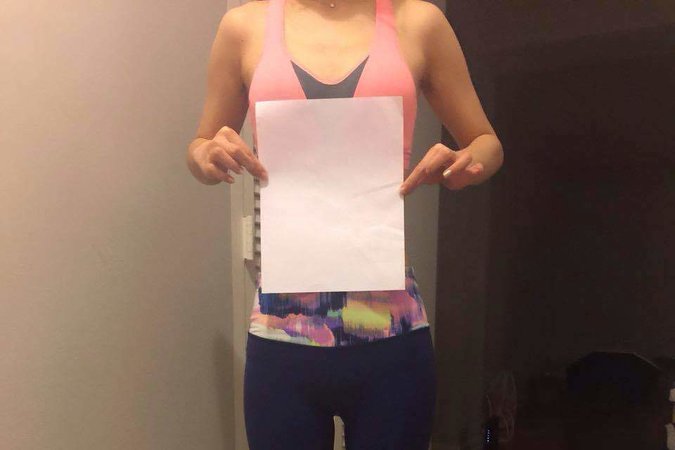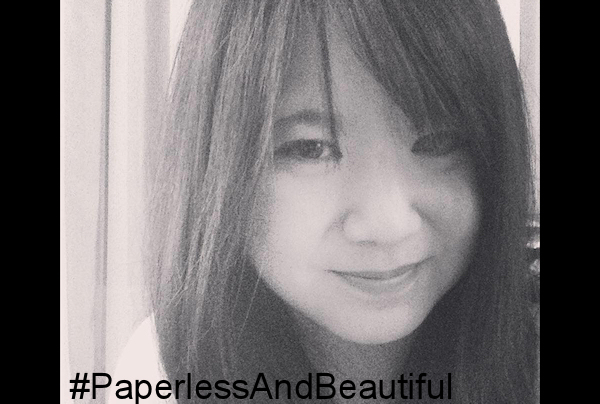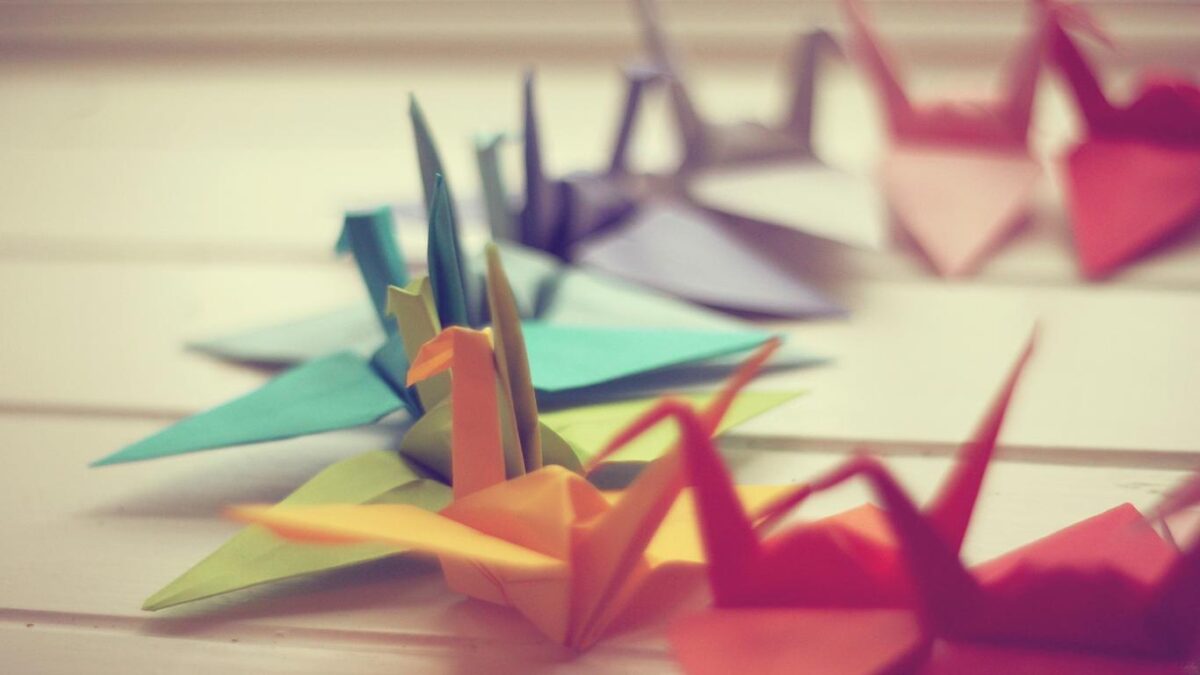I do not have an “A4 Waist,” and I am totally okay with that.
The latest social media trend to take thin-obsessed China by storm is #A4Waist, wherein (predominantly – but not exclusively — female) users post selfies boasting that their waist is so slim that it can be completely obscured by a vertical sheet of A4 paper. The dimensions of A4 paper is 8.3” x 11”, meaning that those who “pass” the A4 Waist Challenge have waists <~17” in diameter.
For those keeping score: In American sizes, this is about 7” smaller than a US size 0.
 A person posts their submission to the #A4Waist hashtag. (Photo Credit: Ms. Liu, via NY Times)
A person posts their submission to the #A4Waist hashtag. (Photo Credit: Ms. Liu, via NY Times)All my life, I have lived within the shackles of Asian American body image issues.
A lot of the conversation about Asian American body image has centered around the core presumption that Asians and Asian Americans are “naturally thin.” As evidence, we point to studies suggesting that our standard body mass index (BMI) tables fail to identify obesity-related symptoms among Asian Americans. We fail to contrast these findings against broader studies showing that metabolic and pre-metabolic syndrome (a metabolic condition that many scientists think is a precursor for development of type II diabetes) is alarmingly common among “healthy BMI” individuals, regardless of race or ethnicity. Instead, we (mis)interpret the science to support the faulty conclusion that Asian Americans are innately skinny, and that a “normal BMI” Asian American is actually obese and unhealthy.
Like most non-scientists, part of the problem is that we overemphasize BMI in general. We forget the reams of evidence that suggest that BMI is an epidemiological measure that is an indirect (and therefore poor) measure of individual health. BMI fails to consider body fat percentage at a given weight (instead assuming that all people with the same weight have the same amount of body fat), or where folks are carrying that fat (whether at their waist or elsewhere). Consider this: the vast majority of type II diabetic patients have higher BMIs, but so too do the vast majority of athletes and fitness enthusiasts.
Nonetheless, Asian and Asian American communities perpetuate an unhealthy relationship between size and beauty that leaves women like me feeling shamed and ostracized. For most of my childhood, I tried – and for far too long, failed – to navigate the minefield of Asian and Asian American beauty myths, which shames us for every morsel of food we eat and every ounce of fat we carry on our bodies. At a size 8-10, my body is by almost every stretch of the imagination completely average. Yet, I grew up believing that because I am Asian American, there is something wrong with me – that I am “fat”, and that if so this is something that should make me hate my body. On top of that, our problematic beauty myths led me to feel insufficiently Asian because of my size.
I think back to a memory when I was 13 or 14 and visiting Hong Kong with my family, when I went into an outlet store looking for a winter coat. The shopkeeper took one look at me and threw me out of the shop, saying I was too big to fit into any of the clothes they sold. As a teenager, I developed a paralyzing fear of clothing shopping that was reinforced by family and friends who casually joked that I was too big to shop in Asian clothing stores. In turn, I thought it was completely healthy to fantasize as a young girl about getting liposection or even more grotesque solutions to slimming down my curves (it’s not). I thought it was completely normal to develop an antagonistic relationship to food, family, friends, and my own body (it’s not).
Most frustrating, however, is that in associating appearance with health, we deemphasize the importance of physical activity and cardiovascular fitness in the equation that leads to a fit body. The “A4 Waist Challenge” is being shared and described as a fitness challenge, which ignores the fact that waist size doesn’t directly translate to health. We readily accept that thin people can be healthy and unthin people can be unhealthy, but we forget that people with large waists can also be physically active and highly fit, while people with small waists can have exceptionally low physical fitness. Consequently, I grew up focusing solely on my body’s appearance rather than my fitness, and so as a child never learned how to maintain a healthy level of physical activity. Only later in life did I embrace physical fitness to combat the negative cardiovascular effects of what was once a largely sedentary lifestyle.
Today, I am highly physically active. I embrace the labels “gym rat” and “lady lifter” with pride. I’m also still curvy, and always will be. The difference is this: these days, I love my Asian American curves. I know I am healthy and beautiful, regardless of my waist size.
But, it shouldn’t have taken thirty years of low self-esteem and internalized fatphobia for me to finally learn this lesson.
#A4Waist may seem like harmless fun, but in reality it is a symptom of a painful Asian and Asian American body image culture that harms many Asian and Asian American women. As a community, we should be able to love and accept our healthy and slim women (and men); for many people, this is their optimal weight and size and we must recognize that.
But we must also recognize that this is not the case for everyone, or even for most people or most Asian American people. Furthermore, a beauty myth that emphasizes thinness as our only metric of beauty places damaging pressure on the many women (and men) whose waists don’t fit the small side of a sheet of paper and yet are led to believe that they should take steps to try to force it to. The study of body image and eating has been traditionally calibrated to Western values and patterns, and so historic studies initially reported low rates of eating disorders in Asian and Asian American communities. However, in more focused studies, some investigators now report that certain forms of disordered eating are high in both Asia and Asian America. This is strongly associated with particularly high prevalence of negative body self-image among Asian and Asian American girls who are fearful that they will gain even small amounts of weight if they follow healthy eating patterns. In parallel, it goes without saying that eating disorders are dangerously unhealthy, and can even be life-threatening.
This should strike all of us as intolerable. No woman should be forced to grow up believing that there is something fundamentally wrong with themselves simply because of the way they appear. No woman should perceive that their value as a human being is dependent primarily on their waist size or some other aspect of their physical appearance. No woman should find themselves facing the impossible choice of rationalizing dangerously disordered eating patterns because of societal pressures telling them that the only way to be beautiful and appropriately Asian American is to be thin.
Quite simply, beauty is not skin deep. Women – including Asian and Asian American women – come in all shapes and sizes. Moreover, our value and beauty lies not in how we appear, but in who we are as powerful, intelligent, and incredible women.
I have nothing against the women of #A4Waist, but with all due respect, fuck any hashtag that would equate our value as women with the size of our waists, rather than to encourage us to find our own personal healthiest selves and to call that beautiful.
Today, I’m sending a different message to our young Asian American girls: I don’t have an A4 waist, and I am #PaperlessAndBeautiful.



